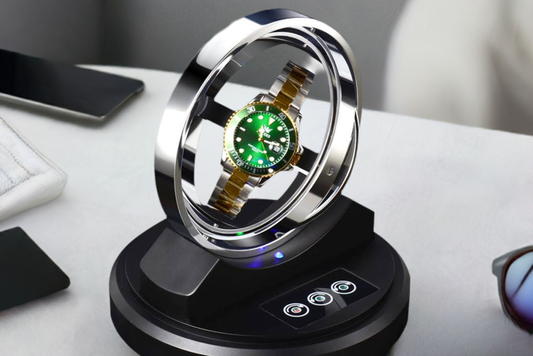Struggling with a loose stretch watch band? Discover the easy steps to resize it perfectly, whether it's a classic Speidel Twist-O-Flex or a modern stretchy band. Learn the tricks of the trade to ensure a comfortable fit without breaking a sweat.
Understanding Stretch Watch Band Types
When it comes to shortening a stretch watch band, it is essential to understand the different types of bands available. Two common types of stretch watch bands are Speidel Twist-O-Flex bands and bands with hidden links or expansion links.
Credit: YouTube Channel - Switza Watches
Speidel Twist-O-Flex Bands
Speidel Twist-O-Flex bands are known for their unique design, which allows them to stretch and fit comfortably around the wrist. However, this design also makes them notoriously tricky to adjust. To shorten a Speidel Twist-O-Flex band, follow these steps:
- Identify the adjustment points: Look for the small metal tabs or nodes on the band. These tabs are the adjustment points where you can shorten or lengthen the band.
- Use a flathead screwdriver: Carefully insert a flathead screwdriver into the gap between the tab and the band. Gently pry the tab away from the band, taking care not to scratch or damage the metal.
- Twist the tab: Once the tab is loose, twist it counterclockwise to shorten the band. You may need to apply gentle pressure to the tab while twisting.
- Check the fit: After shortening the band, try it on to ensure it fits comfortably. If it's still too long, repeat the process until you achieve the desired fit.
Bands with Hidden Links or Expansion Links
Bands with hidden links, such as U-clip expansion links, require a different approach to shorten. Here's how to resize these bands:
- Locate the hidden links: Look for small metal links or U-clips hidden within the band. These links are usually located at the clasp end of the band.
- Use a jeweler's screwdriver or link remover: Carefully insert a jeweler's screwdriver or link remover into the gap between the link and the band. Gently pry the link away from the band, taking care not to scratch or damage the metal.
- Remove excess links: Remove the desired number of links to shorten the band. Be careful not to remove too many links, as this can affect the band's overall appearance.
- Reattach the clasp: Once you've removed the excess links, reattach the clasp to the shortened band. Make sure it's securely fastened to prevent the band from coming loose.
Tools You'll Need
When it comes to shortening a stretch watch band, having the right tools is crucial to ensure a successful and safe process. Here are the essential tools you'll need to complete the job:
- Flat Screwdriver: A flat screwdriver is a versatile tool that can be used to pry open the links and remove the pins.
- Watch Band Tool: A watch band tool is a specialized tool designed specifically for removing links from watch bands.
- Pliers: Pliers can be used to grip the links and hold them in place while you remove the pins.
- Pin Pusher: A pin pusher is a small tool used to push out the pins from the links.
- Soft Cloth: A soft cloth is used to protect the watch band from scratches and damage during the resizing process.
Step-by-Step Guide
1. Identifying Pins and Tabs
Before you start shortening your stretch watch band, it's essential to identify the pins and tabs that hold the links together. The pins are small metal rods that connect the links, while the tabs are small metal pieces that secure the pins in place.
2. Removing Links Safely
Once you've identified the pins and tabs, it's time to remove the links. Here's a step-by-step guide on how to remove links safely:
- Hold the watch band in your hand and identify the link you want to remove.
- Use a flat screwdriver or watch band tool to pry open the link. Gently insert the tool into the gap between the links and twist it until the link opens.
- Use a pin pusher or watch band tool to push out the pin. Hold the link in place with pliers and gently push out the pin with the tool.
- Repeat the process for each link you want to remove.
3. Adjusting for Different Designs
Not all stretch watch bands are created equal, and some may have internal or external tabs that require special attention.
- Internal Tabs: If your watch band has internal tabs, you'll need to use a watch band tool or pin pusher to push out the pins from the inside of the link.
- External Tabs: If your watch band has external tabs, you can use a flat screwdriver or watch band tool to pry open the link and remove the pin.
4. Reassembling the Band
Once you've removed the necessary links, it's time to reassemble the watch band. Here are some tips to ensure a secure fit and maintain the band's integrity:
- Hold the watch band in your hand and identify the links you want to reattach.
- Use a flat screwdriver or watch band tool to pry open the link and insert the pin.
- Hold the link in place with pliers and gently push the pin into place.
- Repeat the process for each link you want to reattach.
- Once you've reattached all the links, check the watch band to ensure it's securely fastened and comfortable to wear.
To DIY or Not to DIY
When it comes to shortening a stretch watch band, one of the first decisions to make is whether to seek professional help or take the DIY route. Both options have their advantages and disadvantages, and understanding these can help you make an informed decision.
When to Call in a Watchmaker or Jeweler
There are certain situations where it is highly recommended to seek the help of a professional watchmaker or jeweler. For instance, if your watch band is made of a precious metal like gold or silver, or if it features intricate designs or engravings, it's best to leave the shortening process to an expert. Similarly, if your watch is a high-end luxury brand or an antique piece, you may want to ensure that any alterations are done by someone with the necessary expertise and experience to avoid damaging the timepiece.
Benefits of Professional Service
One of the main benefits of seeking professional help is the assurance that the job will be done correctly and safely. Watchmakers and jewelers have the necessary training and experience to handle delicate watch components, and they can ensure that your watch band is shortened to the correct size without damaging the watch or the band.
Benefits of DIY
On the other hand, taking the DIY route can be a cost-effective and satisfying way to shorten your stretch watch band. With the right tools and a bit of patience, you can save money and enjoy the sense of accomplishment that comes with doing the job yourself.
Addressing Unique Challenges
For the topic "How to Shorten a Stretch Watch Band," addressing unique challenges like bands without visible pins or stretchy materials that don't have traditional links requires careful consideration and research.
Problem: Bands Without Visible Pins
One common issue with stretch watch bands is the lack of visible pins, making it difficult to adjust or shorten the band. To address this, you can use specialized tools designed for this purpose, such as the Adjustable Watch Band Tool by Bergeon.
Problem: Stretchy Materials Without Traditional Links
Another challenge is dealing with stretchy materials that don't have traditional links. In such cases, the band cannot be shortened by removing links. One solution is to use a Watch Band Cutter specifically designed for cutting stretchy materials like rubber or silicone.
Maintaining Your Shortened Band
Shortening a stretch watch band can be a daunting task, but with the right techniques and materials, it can be done efficiently and effectively. Once you've successfully resized your watch band, it's essential to maintain it properly to ensure long-lasting comfort and durability.
Cleaning Your Watch Band
Regular cleaning is crucial to prevent dirt and grime from accumulating on your watch band. For stretch watch bands made of rubber, silicone, or nylon, use a soft, dry cloth to wipe away any dirt or debris. For leather watch bands, use a leather cleaner specifically designed for the type of leather your band is made of.
Avoiding Extreme Temperatures
Extreme temperatures can cause your watch band to degrade or become brittle. Avoid exposing your watch band to direct sunlight, especially in hot climates, as this can cause the material to fade or crack. Similarly, avoid wearing your watch in extremely cold temperatures, as this can cause the material to become stiff or brittle.
Storing Your Watch
When not in use, it's essential to store your watch properly to prevent damage to the band. Avoid stacking your watch on top of other items, as this can cause pressure on the band and lead to stretching or deformation. Instead, store your watch in a cool, dry place, away from direct sunlight. You can also use a watch case or box to protect your watch and band from dust and scratches.
Avoiding Chemical Exposure
Chemicals like perfume, cleaning products, or pesticides can damage your watch band, especially if it's made of leather or rubber. Avoid exposing your watch band to these chemicals, and if you must use them, make sure to wash your hands thoroughly before handling your watch. If you accidentally expose your watch band to chemicals, clean it immediately with a mild soap solution and water.
Conditioning Your Leather Watch Band
If you have a leather watch band, regular conditioning can help maintain its suppleness and prevent cracking. Use a leather conditioner specifically designed for the type of leather your band is made of, and apply it to a soft cloth. Gently rub the conditioner onto the band, paying special attention to the areas that tend to crack or dry out. Let the conditioner dry completely before wearing your watch.
Inspecting Your Watch Band Regularly
Regular inspections can help you identify any potential issues with your watch band before they become major problems. Check your watch band regularly for signs of wear, such as cracks, scratches, or stretching. If you notice any damage, consider replacing the band or taking it to a professional watch repair service.
FAQs
Q: Can I shorten any type of stretch watch band?
A: While most stretch watch bands can be shortened using the methods mentioned above, some bands may have specific requirements or limitations. It's essential to consult the manufacturer's instructions or contact their customer support for guidance on shortening their particular band.
Q: How do I shorten an Apple Watch band?
A: Apple Watch bands, such as the Apple Watch Sport Band or the Apple Watch Leather Band, can be shortened using the adjustable clasp method. For bands without an adjustable clasp, you may need to remove links or use a watch band shortening tool.
Q: What tools do I need to shorten a stretch watch band?
A: The tools required to shorten a stretch watch band vary depending on the method chosen. For adjusting the clasp, no additional tools are needed. For removing links, a watch link remover tool is necessary. For using a watch band shortening tool, the specific tool designed for that purpose is required.
Q: Can I shorten a stretch watch band myself, or should I take it to a professional?
A: While shortening a stretch watch band can be done DIY-style, it's recommended to seek professional help if you're unsure or uncomfortable with the process. A professional watch repair service can ensure the job is done correctly and efficiently, preventing any potential damage to the band or watch.
Q: How much does it cost to shorten a stretch watch band?
A: The cost of shortening a stretch watch band varies depending on the method and tools used. DIY methods, such as adjusting the clasp or removing links, are essentially free. Using a watch band shortening tool may require an initial investment of $5-$15. Professional watch repair services may charge anywhere from $10 to $50, depending on the complexity of the task and the service provider.
Conclusion
Say goodbye to ill-fitting stretch watch bands with this comprehensive guide. Whether you're a DIY enthusiast or considering professional help, find your perfect fit with confidence. Share your experiences and tips in the comments below, and let's keep the conversation going!




